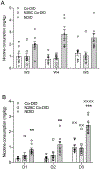Differential patterns of alcohol and nicotine intake: Combined alcohol and nicotine binge consumption behaviors in mice
- PMID: 31557515
- PMCID: PMC7085962
- DOI: 10.1016/j.alcohol.2019.09.006
Differential patterns of alcohol and nicotine intake: Combined alcohol and nicotine binge consumption behaviors in mice
Abstract
Late adolescence and young adulthood, corresponding to the high school and college years, are vulnerable periods for increased alcohol and nicotine use. The dramatic increase in the prevalence of electronic cigarette use is particularly concerning in these age groups. Late adolescents and young adults are more likely to engage in cycles of binge drug consumption, and alcohol and nicotine are frequently used together. However, there are few data examining the combination of alcohol and nicotine in binge models in animal models. In this study, our objectives were to determine how voluntary nicotine consumption beginning in late adolescence influenced subsequent binge alcohol consumption in young adulthood, how a combination of alcohol and nicotine binge consumption differed from alcohol-only binge consumption, and whether nicotine would be consumed when presented in a binge procedure. Male C57BL/6J mice voluntarily consumed unsweetened alcohol and nicotine in continuous-access bottle-choice procedures in combination with cycles of drinking-in-the-dark. Our results show that experience with voluntary nicotine consumption in late adolescence did not affect subsequent binge alcohol consumption in early adulthood. However, mice that consumed nicotine in adolescence showed an initial decrease in alcohol preference, and consequently increase in nicotine preference, on the first session of combined ethanol and nicotine binge consumption in adulthood compared with mice that drank only water during late adolescence. Lastly, we found that mice readily consumed unsweetened nicotine when presented in a binge procedure, and the level of consumption exceeded the nicotine consumption observed in the combination alcohol and nicotine binge. Our data show that expansion of the patterns of alcohol and nicotine co-consumption in a mouse models is possible, which will enable us to dissect relevant molecular targets underlying these consumption patterns and better inform drug development efforts.
Keywords: Adolescent; Binge; Ethanol; Mice; Nicotine.
Copyright © 2019 Elsevier Inc. All rights reserved.
Conflict of interest statement
Declaration of Competing Interest The authors have no conflicts to report.
Figures





Similar articles
-
Concomitant Caffeine Increases Binge Consumption of Ethanol in Adolescent and Adult Mice, But Produces Additive Motor Stimulation Only in Adolescent Animals.Alcohol Clin Exp Res. 2016 Jun;40(6):1351-60. doi: 10.1111/acer.13089. Epub 2016 May 7. Alcohol Clin Exp Res. 2016. PMID: 27154344 Free PMC article.
-
Unequal interactions between alcohol and nicotine co-consumption: suppression and enhancement of concurrent drug intake.Psychopharmacology (Berl). 2020 Apr;237(4):967-978. doi: 10.1007/s00213-019-05426-6. Epub 2019 Dec 20. Psychopharmacology (Berl). 2020. PMID: 31858160 Free PMC article.
-
Repeated cycles of binge-like ethanol (EtOH)-drinking in male C57BL/6J mice augments subsequent voluntary EtOH intake but not other dependence-like phenotypes.Alcohol Clin Exp Res. 2013 Oct;37(10):1688-95. doi: 10.1111/acer.12145. Epub 2013 May 3. Alcohol Clin Exp Res. 2013. PMID: 23647551 Free PMC article.
-
Sex- and age-dependent impacts of nicotine and ethanol binge drinking on the brain: Insights from preclinical research.J Neurochem. 2025 Feb;169(2):e16249. doi: 10.1111/jnc.16249. Epub 2024 Oct 24. J Neurochem. 2025. PMID: 39449196 Review.
-
Adolescent alcohol exposure: Are there separable vulnerable periods within adolescence?Physiol Behav. 2015 Sep 1;148:122-30. doi: 10.1016/j.physbeh.2015.01.027. Epub 2015 Jan 23. Physiol Behav. 2015. PMID: 25624108 Free PMC article. Review.
Cited by
-
Alcohol consumption during early adulthood increases the vulnerability of locus coeruleus neurons and amyloid beta pathology in female APP/PS1 mice.Alcohol. 2025 Sep;127:1-9. doi: 10.1016/j.alcohol.2025.05.004. Epub 2025 May 21. Alcohol. 2025. PMID: 40409612
-
Sex chromosome and gonadal hormone contributions to binge-like and aversion-resistant ethanol drinking behaviors in Four Core Genotypes mice.Front Psychiatry. 2023 Mar 7;14:1098387. doi: 10.3389/fpsyt.2023.1098387. eCollection 2023. Front Psychiatry. 2023. PMID: 36960454 Free PMC article.
-
Midazolam, methamphetamine, morphine and nicotine intake in high-drinking-in-the-dark mice.Addict Biol. 2022 Sep;27(5):e13212. doi: 10.1111/adb.13212. Addict Biol. 2022. PMID: 36001437 Free PMC article.
-
Adolescent alcohol and nicotine exposure alters the adult response to alcohol use.Adv Drug Alcohol Res. 2023 Nov 22;3:11880. doi: 10.3389/adar.2023.11880. eCollection 2023. Adv Drug Alcohol Res. 2023. PMID: 38389816 Free PMC article. Review.
-
Dopamine Circuit Mechanisms of Addiction-Like Behaviors.Front Neural Circuits. 2021 Nov 9;15:752420. doi: 10.3389/fncir.2021.752420. eCollection 2021. Front Neural Circuits. 2021. PMID: 34858143 Free PMC article. Review.
References
-
- Ames SC, Pokorny SB, Schroeder DR, Tan W, & Werch CE (2014). Integrated smoking cessation and binge drinking intervention for young adults: a pilot efficacy trial. Addict Behav, 39(5), 848–853. - PubMed
-
- Batel P, Pessione F, Maitre C, & Rueff B (1995). Relationship between alcohol and tobacco dependencies among alcoholics who smoke. Addiction, 90(7), 977–980. - PubMed
-
- Beets MW, Flay BR, Vuchinich S, Li KK, Acock A, Snyder FJ et al. (2009). Longitudinal patterns of binge drinking among first year college students with a history of tobacco use. Drug Alcohol Depend, 103(1–2), 1–8. - PubMed
-
- Burke AR, McCormick CM, Pellis SM, & Lukkes JL (2017). Impact of adolescent social experiences on behavior and neural circuits implicated in mental illnesses. Neurosci Biobehav Rev, 76(Pt B), 280–300. - PubMed
Publication types
MeSH terms
Substances
Grants and funding
LinkOut - more resources
Full Text Sources

